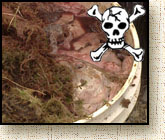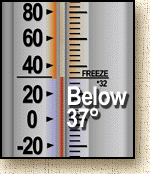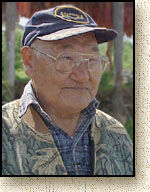|



By following five food safety tips you can protect
yourself and your family from getting botulism when you prepare Native
foods.
|

Gina
Carpenter, RN
Nurse, Kanakanak Hospital
Dillingham, Alaska
|
"We know that people get
botulism
from fermented foods such as stinky heads and stinky beaver
tail. There
are many lessons that we can learn
from the helping
hands of the elders.
Its been shown that older, traditional
methods of making fermented food
are less likely to make the
botulism poison than the newer methods of
using plastic."
|


|
By washing your hands with soap and water, you wash
away germs that you get from touching a contaminated surface. Also, clean
the containers and areas where food will be placed. Wash your food before
preparing it. This reduces the germs, but does not remove all of them.
These tips are
|
| also important steps in preventing other diseases you can
get from food.
|


|
Eating fermented food has some risk of botulism. To
reduce your risk of botulism, ferment food by using the traditional method
of a grass-lined hole in the ground. Use methods that allow the air to
circulate.
|

|
Because
botulism grows better when
fresh air is not moving
around, do
NOT use plastic or glass
containers. Even a plastic container
without a lid may allow the botulism germ to grow in the bottom of the
container.
|
|
Use salt when drying fish. Salt is a natural preservative and reduces
the chance that botulism poison will grow.
|
|
"My
personal opinion, after 35 years in Alaska, is that the increase in
botulism is directly related to the
use of glass jars and plastic
buckets, to store and to ferment fish. The old traditional methods,
although not foolproof, are safer than the current methods of
storing and preparing
the fish products. In the past, there were
more open air containers. They used grass baskets versus plastic
buckets. The foods were put into the ground rather than stored in
glass
jars in warm rooms."
|

Dan O'Connell, MD
Physician, Kanakanak Hospital
Dillingham, Alaska
|
|

Sacally
Botulism survivor
|
"Older
people used grass
and moss. They put them [the fermented fish] under
the
ground and left them there,
not in plastic."
|


|
Keep food cold by fermenting it in
the ground and away
from the sun.
Ideally, the
temperature of the food should be below 37 degrees
Fahrenheit. It might take longer to ferment the food, but it may
be safer because if you keep food cold, you prevent botulism poison
from developing.
|
 |
|
"We
have to hide
them from the sun
to keep them
cold down there."
|

Elia
Botulism survivor |
|

Karen Atakitlig
Community Health Practitioner Togiak, Alaska
|
"I
think people are learning. I have seen people making fermented fish
heads underground. They keep it well-ventilated and in a dark cold
place instead of covering it with a bucket cover so it would not be so
tight." |
|
"Follow the traditional ways of preparing food. Do not use any
short cuts to get them ready faster. Do not use plastic containers."
|

Marie
Botulism survivor
|


|
Botulism toxin is destroyed by high heat. Boiling fermented food for 10
minutes can destroy the botulism poison. It might change the taste from
what you are used to, but it is one way to protect you and your family
from botulism.
|
| If fermented foods are stored in plastic or glass containers before
they are eaten, they should be boiled because the botulism poison cannot
be seen, smelled, or tasted. Boiling will kill the poison that is in the
food. |

|
It is much better to throw out food that might be
contaminated than to eat it and get sick or lose the life of a loved one.
Be sure to throw out contaminated food where it cannot be eaten by
children or pets.
In addition, know how the food you
|
 |
|
eat is made. If you are not sure,
then don't eat it. Botulism poison is so strong that even a small taste
can cause serious problems. |
|

Barbara Riley, MD
Physician,
Kanakanak Hospital
Dillingham, Alaska
|
"We know how important our
traditional Native foods are, but we must be very careful in how we
prepare our foods. If people want to continue eating their fermented
heads they need to not use any plastic to ferment them. Using the
traditional hole in the ground is better but there is still always
the possibility that botulism can infect that head. I would
recommend that people boil their foods for a minimum of 10 minutes.
People need to be very, very careful when theyre eating their
fermented Native foods. If they have any symptoms at all, they need
to see a health care provider very quickly, not wait at home or in
their village." |

|
 |
Wash your hands, containers, and food before
you start preparing food. |
 |
Eating fermented food has some risk of botulism. To reduce your
risk, ferment food by using the traditional method of a
grass-lined hole in the ground. Use methods that allow the air to
circulate. |
 |
Do NOT use plastic or glass containers. |
 |
Salt your food before drying it. |
 |
Keep food cold by fermenting it in the ground, away from the
sun. |
 |
Consider boiling your fermented food for 10 minutes before you
eat it. This will destroy the poison and protect you from
botulism. |
 |
When in doubt, throw it out! |
|
By following these simple tips, you can give a helping
hand and keep your family safe from botulism
|
|




